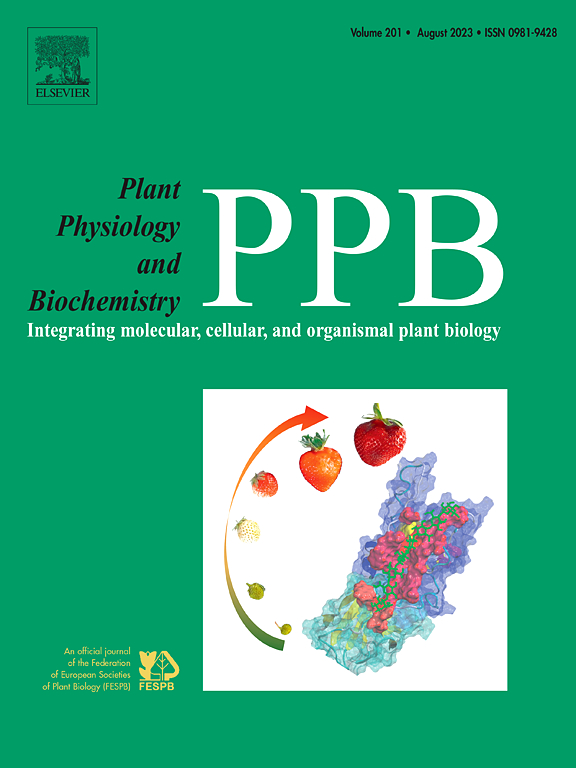The PuWRKY29-PuMYB62 module responds to salicylic acid to inhibit the synthesis of stone cells in ‘Nanguo’ pear
IF 5.7
2区 生物学
Q1 PLANT SCIENCES
引用次数: 0
Abstract
Stone cells serve as pivotal determinants of pear fruit quality, with their formation exhibiting a strong correlation with lignification processes. As a phenolic signaling molecule with multiple biological functions, salicylic acid (SA) plays essential roles in regulating fruit growth and developmental processes. Nevertheless, the molecular mechanisms underlying SA-mediated modulation of stone cell differentiation in pears remain poorly characterized. Our investigation revealed that exogenous application of 15 mg L−1 SA decreased lignified stone cell formation in ‘Nanguo’ (Pyrus ussuriensis) pear fruits and significantly downregulating the expression of the lignin biosynthesis-related PuPRX64. mRNA-seq identified two transcription factors, PuWRKY29 and PuMYB62, which were significantly induced by SA. Functional characterization through transient expression assays in pear fruits and stable transgenic calli demonstrated that both factors act as negative regulators of stone cell formation and lignin accumulation. PuWRKY29 binds to the W-box cis-element within the PuMYB62 promoter to activate its transcription, while simultaneously forming a protein complex that synergistically represses PuPRX64 expression. Collectively, our findings suggest that exogenous SA treatment inhibits stone cell and lignin biosynthesis in pears via the PuWRKY29-PuMYB62 regulatory module.
PuWRKY29-PuMYB62模块响应水杨酸抑制‘南果’梨石细胞的合成
石细胞是梨果实质量的关键决定因素,它们的形成与木质化过程有很强的相关性。水杨酸(salicylic acid, SA)是一种具有多种生物学功能的酚类信号分子,在调节果实生长发育过程中起重要作用。然而,梨中sa介导的石细胞分化调控的分子机制仍不清楚。本研究发现,外源施加15 mg L−1 SA可降低“南国”(Pyrus ussuriensis)梨果实木质素化石细胞的形成,并显著下调木质素合成相关基因PuPRX64的表达。mRNA-seq鉴定出两个转录因子PuWRKY29和PuMYB62,它们被SA显著诱导。通过在梨果实和稳定的转基因愈伤组织中瞬时表达的功能鉴定表明,这两个因子都是石细胞形成和木质素积累的负调控因子。PuWRKY29与PuMYB62启动子内的W-box顺式元件结合,激活其转录,同时形成一个协同抑制PuPRX64表达的蛋白复合物。总之,我们的研究结果表明,外源SA处理通过PuWRKY29-PuMYB62调节模块抑制梨石细胞和木质素的生物合成。
本文章由计算机程序翻译,如有差异,请以英文原文为准。
求助全文
约1分钟内获得全文
求助全文
来源期刊
CiteScore
11.10
自引率
3.10%
发文量
410
审稿时长
33 days
期刊介绍:
Plant Physiology and Biochemistry publishes original theoretical, experimental and technical contributions in the various fields of plant physiology (biochemistry, physiology, structure, genetics, plant-microbe interactions, etc.) at diverse levels of integration (molecular, subcellular, cellular, organ, whole plant, environmental). Opinions expressed in the journal are the sole responsibility of the authors and publication does not imply the editors'' agreement.
Manuscripts describing molecular-genetic and/or gene expression data that are not integrated with biochemical analysis and/or actual measurements of plant physiological processes are not suitable for PPB. Also "Omics" studies (transcriptomics, proteomics, metabolomics, etc.) reporting descriptive analysis without an element of functional validation assays, will not be considered. Similarly, applied agronomic or phytochemical studies that generate no new, fundamental insights in plant physiological and/or biochemical processes are not suitable for publication in PPB.
Plant Physiology and Biochemistry publishes several types of articles: Reviews, Papers and Short Papers. Articles for Reviews are either invited by the editor or proposed by the authors for the editor''s prior agreement. Reviews should not exceed 40 typewritten pages and Short Papers no more than approximately 8 typewritten pages. The fundamental character of Plant Physiology and Biochemistry remains that of a journal for original results.

 求助内容:
求助内容: 应助结果提醒方式:
应助结果提醒方式:


